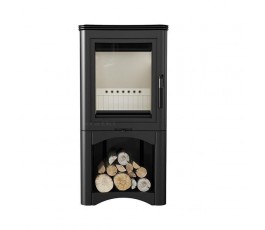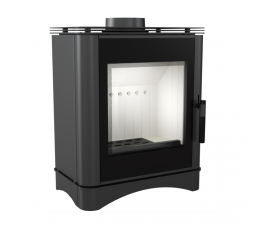Kratki Free Standing Stoves

Steel and cast iron
For freestanding
stoves the material they are made of is particularly important. It not only
affects the styling of the device but also its characteristics. Properties
of the material affect how rapidly heat is released into the premises and the
time over which the stove is able to keep on releasing the accumulated heat.
Steel
stoves
These are made using cutting
edge machining methods.
Cast
iron stoves
These are classic
solutions, based on durable massive casts
Advantages
Power rating
As
a rule of thumb, 1 kW of power is sufficient to heat 10-12 m². Thus we can
select a correct model depending on the area in question.
Use of heat
A
stove releases heat throughout its entire surface, and that includes the
chimney duct.
Light structure
Smaller
weight does away with the need to reinforce floor - ceiling assemblies.
Freedom to design interiors
A
stove does not require any additional structural elements, it can be located
anywhere as long as a chimney duct can be attached to it.
Ease of mounting
A
freestanding stove only requires connection to a chimney duct. It does not
require any additional structural or other elements, which reduces costs.
Design
The
freestanding stoves or hearths enjoy unwavering interest. Every interior will
find its perfect partner in the wide range of available models. The materials
used in the production of stoves also determines their style and appearance.
KOZA AB Pedestal
Stove AB with cylindrical, modern design is a great solution for people who long for warmth, but do not have a large space in their interior.Technical specificationRated output (kW) 8,0 Range of heating power (kW) 5.5 - 10.5 Efficiency (%) 78,0 Exhaust outlet diameter (mm) 150 Complies with Eco-design criteria Yes Designed for heat recovery unit Yes Fuel type recommended seasoned hardwood with moisture ≤20% Weight (kg) 108,0 CO emission (at 13% O 2 ) ≤ given in % 0,08 Flue gas temperature (℃) 265,0 Max log length (cm) 25 Emission of dust (mg/Nm ) 39,0 Compliance with BImSchV 2 standard Yes The energy efficiency index EEI 102,79Glazing type quadrant Opening of the doors to the left Material steel Width (cm) 52,80 Height (cm) 108,60 Depth (cm) 42,20 External air inlet Yes The liner of the combustion chamber Yes Ashpan Yes Decorative printed glass No ASDP - automatic control of the air supply No Turbine TURBOFAN No Water panel No MAXIMUM USE OF ENERGYThe body and the front of th..
1,500.00€ Ex Tax: 1,219.51€
KOZA AB S/DR
Stove AB with cylindrical, modern design is a great solution for people who long for warmth, but do not have a large space in their interior. Technical specificationRated output (kW) 8,0 Range of heating power (kW) 5.5 - 10.5 Efficiency (%) 78,0 Exhaust outlet diameter (mm) 150 Complies with Eco-design criteria Yes Designed for heat recovery unit Yes Fuel type recommended seasoned hardwood with moisture ≤20% Weight (kg) 110,0 CO Emission (at 13% O 2 ) ≤ given in % 0,08 Flue gas temperature (℃) 265,0 Max log length (cm) 25 Emission of dust (mg/Nm ) 39,0 Compliance with BImSchV 2 standard Yes The energy efficiency index EEI 102,79 Glazing type quadrant Opening of the doors to the leftMaterial steel, cast iron Width (cm) 52,80 Height (cm) 105,20 Depth (cm) 42,20 External air inlet Yes The liner of the combustion chamber Yes Ashpan Yes Decorative printed glass No ASDP - automatic control of the air supply No Turbine TURBOFAN No Water panel No. MAXIMUM USE OF ENERGYThe b..
1,500.00€ Ex Tax: 1,219.51€
Koza Enyo Panoramic 6kw
A modern device meeting the strictest environmental standards. It is the ideal answer to current architectural trends. Perfect proportions combined with a unique vision of fire make ENYO fit perfectly into any interior. Technical SpecificationsRated output (kW) 6,0Range of heating power (kW) 4.0 - 8.0Efficiency (%) 80,0Exhaust outlet diameter (mm) 150Complies with Eco Design criteria YesDesigned for heat recovery unit YesFuel type seasoned hardwood (moisture ≤20%), CO emission (at 13% O 2 ) ≤ given in % 0,10Flue gas temperature (℃) 239,0Max log length (cm) 30Emission of dust (mg/Nm 3) 30,0Compliance with BImSchV 2 standard YesThe energy efficiency index EEI 107,00Glazing type roundedOpening of the doors left-handMaterial steelWidth (mm) 509Height (mm) 1128Depth (mm) 434External air inlet YesThe liner of the combustion chamber YesAshpan YesDecorative printed glass YesCoil NoTurbine TURBOFAN No FeaturesThe ENYO free-standing stove is a modern device meet..
1,230.00€ 2,000.00€ Ex Tax: 1,000.00€
KOZA K5
Technical Specifications Rated output (kW) - 7,0 Range of heating power (kW) 5.5 - 9.0 Efficiency (%) - 76,0 Exhaust outlet diameter (mm) – 150 Complies with Ecodesign criteria – Yes Designed for heat recovery unit - No Fuel type - recommended seasoned hardwood with moisture ≤20% Weight (kg) -118,0 CO emission (at 13% O 2 ) ≤ given in % 0,09 Flue gas temperature (℃) 250,0 Max log length (cm) 25 Emission of dust (mg/Nm 3) 40,0 Compliance with BImSchV 2 standard – Yes The energy efficiency index EEI 100,18 Glazing type – straight Opening of the doors - to the left Material - cast iron, steel Width (cm) 45,20 Height (cm) 62,80 Depth (cm) 40,60 External air inlet – No The liner of the combustion chamber – Yes Ashpan – Yes Decorative printed glass – No ASDP - automatic control of the air supply – No Turbine TURBOFAN – No Water panel - No Max..
1,230.00€ Ex Tax: 1,000.00€
KOZA K5 Pedestal
Freestanding Stove K5 S with a log box. Despite its small size, it has excellent thermal parameters.Technical dataNominal power (kW) 7.0Range of heating power (kW) 5.5 – 9.0Thermal efficiency (%) - 76.0Diameter of the pipe (mm) - 150Designed for recovery - notFuel - allowed lignite briquettes recommended seasoned hardwoodWeight (kg) - 119.0CO (with 13% O 2) given in% ≤ 0.09Flue gas temperature (℃) - 250.0Max log length (cm) - 25The issue of pollen (dust) (mg / Nm 3 ) - 40.0Compliance BlmSchV 2 - YesType of glazing- SimpleOpening the door - to the leftMaterial - steelWidth (cm) - 45.20Height (cm) - 94.20Depth (cm) - 41.00Air intake - notThe liner of the combustion chamber - YesAshpan - YesDecorative glass type glass - NotASDP – automatic control of air supply - NotTurbine Turbofan - NotPanel Water - Not MAXIMUM USE OF ENERGYThe body and the front of the insert are resistant to high temperatures thanks to the high quality steel used in production.Combustion of fuel thank..
1,230.00€ Ex Tax: 1,000.00€
KOZA K5 with closed log box
Freestanding Stove K5 S with a log box. Despite its small size, it has excellent thermal parameters.Technical dataNominal power (kW) 7.0Range of heating power (kW) 5.5 – 9.0Thermal efficiency (%) - 76.0Diameter of the pipe (mm) - 150Designed for recovery - notFuel - allowed lignite briquettes recommended seasoned hardwoodWeight (kg) - 132.0CO (with 13% O 2) given in% ≤ 0.09Flue gas temperature (℃) - 250.0Max log length (cm) - 25The issue of pollen (dust) (mg / Nm 3 ) - 40.0Compliance BlmSchV 2 - YesType of glazing- SimpleOpening the door - to the leftMaterial - steelWidth (cm) - 46.20Height (cm) - 92.60Depth (cm) - 40.00Air intake - notThe liner of the combustion chamber - YesAshpan - YesDecorative glass type glass - NotASDP – automatic control of air supply - NotTurbine Turbofan - NotPanel Water - Not MAXIMUM USE OF ENERGYThe body and the front of the insert are resistant to high temperatures thanks to the high quality steel used in production.Combustion of fuel thank..
1,230.00€ Ex Tax: 1,000.00€
KOZA K5 with log box
Freestanding Stove K5 S with a log box. Despite its small size, it has excellent thermal parameters.Technical dataNominal power (kW) 7.0Range of heating power (kW) 5.5 – 9.0Thermal efficiency (%) - 76.0Diameter of the pipe (mm) - 150Designed for recovery - notFuel - allowed lignite briquettes recommended seasoned hardwoodWeight (kg) - 127.0CO (with 13% O 2) given in% ≤ 0.09Flue gas temperature (℃) - 250.0Max log length (cm) - 25The issue of pollen (dust) (mg / Nm 3 ) - 40.0Compliance BlmSchV 2 - YesType of glazing- SimpleOpening the door - to the leftMaterial - steelWidth (cm) - 46.20Height (cm) - 92.60Depth (cm) - 39.90Air intake - notThe liner of the combustion chamber - YesAshpan - YesDecorative glass type glass - NotASDP – automatic control of air supply - NotTurbine Turbofan - NotPanel Water - Not MAXIMUM USE OF ENERGYThe body and the front of the insert are resistant to high temperatures thanks to the high quality steel used in production.Combustion of fuel thank..
1,230.00€ Ex Tax: 1,000.00€
KOZA VEGA
Stove VEGA is a tradition in the new version. Despite its small size, it has excellent thermal parameters. Technical specificationRated output (kW) 6,0 Range of heating power (kW) 3.5 - 8.0 Efficiency (%) 78,0 Exhaust outlet diameter (mm) 130 Complies with Eco-design criteria Yes Designed for heat recovery unit No Fuel type recommended seasoned hardwood with moisture ≤20%Weight (kg) 90,0 CO emission (at 13% O 2 ) ≤ given in % 0,10 Flue gas temperature (℃) 280,0 Max log length (cm) 25 Emission of dust (mg/Nm ) 21,0 Compliance with BImSchV 2 standard Yes The energy efficiency index EEI 102,79 Glazing type straight Opening of the doors to the leftMaterial steel, cast iron Width (cm) 51,00 Height (cm) 64,90 Depth (cm) 31,50 External air inlet No The liner of the combustion chamber Yes Ashpan Yes Decorative printed glass Yes ASDP - automatic control of the air supply No Turbine TURBOFAN No Water panel No MAXIMUM USE OF ENERGYThe body and the front of the insert a..
1,107.00€ Ex Tax: 900.00€
















